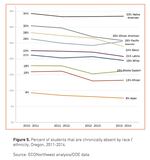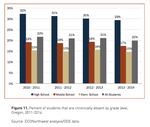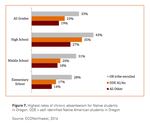
A school hallway sits empty.
Rob Manning / OPB
Oregon education leaders have published an in-depth analysis of why some students frequently miss school.
Twenty percent of Oregon students are considered “chronically absent,” because they miss at least one day of school every two weeks. Researchers explored why it’s a bigger problem for certain student groups — such as Native American children, other students of color and kids with disabilities.
Oregon Chief Education Officer Lindsey Capps said students felt a disconnect when teachers didn’t look like them or understand their background.
“One of the most significant and common themes that were voiced by students was the importance of relationships to their feeling connected to school and supported in their learning,” Capps said.
The study from Oregon's Chief Education Office, Portland State University and the Coalition of Communities of Color includes dozens of comments from 44 focus groups that researchers led throughout Oregon.
One echoed Capps' statement, pleading, "My child just needs someone to connect to her everyday. Not much — just a 'hello' and 'goodbye' and 'looking forward to seeing you tomorrow' is enough."
Racial And Class Bias

Rates of chronic absence vary widely by ethnic group. With about one in three Native American students reported as chronically absent, but only one in 12 Asian students.
Oregon Chief Education Office / Oregon Department of Education
Racial and class bias among school teachers and administrators came up regularly.
"Teachers don't care about us or our children," one parent of color said in a focus group. "They don't see us as capable. They feel as if our kids won't make it and the kids know it."
"Not all teachers are bad," another said. "Usually the racism they show is not direct. Many times it's not what they say, but what they do or don't do."
Others shared examples of teachers and administrators who were more supportive or made more of an effort with children of color and said those efforts made a difference in children's feelings toward school.
Finding A Connection To School
The study looked into other relationships including teachers with parents, and schools with community-based organizations. It concluded that strengthening those relationships could help provide a support network that would foster regular student attendance.
Students also said the subject matter taught in class could be a turnoff to coming to school.

Oregon made marginal progress in reducing rates of chronic absenteeism from 2010 to 2014.
Oregon Chief Education Office / Oregon Department of Education
"They make me take classes that I won't ever use, and I don't have enough time to focus on the courses that really matter," complained one student whom the study identifies as "headed for higher education."
Some students reported feeling like they were struggling to graduate. Others yearned for courses that were more relevant to jobs they might get.
"If we could build it, they would be excited to come to school," said a school superintendent as a vote of support for career-relevant education.
Building Student Support
Parents and students also called for more supports for students who are struggling, and a more supportive — and less critical — attitude from teachers.
One parent said of his or her young child:
“The first time I heard him say 'I'm not smart,' I was, 'Oh God, I've got to you out of here,' I know I'm not giving him those messages at home ... For somebody to say he is just not trying, he would cry at home and say 'I'm trying, I'm trying.' To say 'You can do it, but you are not trying' and you know inside that you are trying harder than you have ever tried, so he comes up with 'I must be not smart.' The importance of what you say sticks with these little ones. It makes a huge impact.”
The study points to a “huge set of circumstances” that are more systemic, that may also contribute to patterns of low student attendance. For instance, families referred to the high cost of child care and the need to have older children sometimes fill in the gaps.
"Sometimes the parents don't want to pay a babysitter, and they have to work," said one parent. "They let the older children take care of them."
Breaking Barriers
Transportation can also be a problem, and for immigrant parents who speak languages other than English, the language barrier can be significant.
"For me, we focus on working, working all the time and we don't go to school for English," one parent told researchers. "The reality is that in my case since we have the language barriers, sometimes we don't send our kids to school or we take them out of school to help us interpret."
The study identifies problems with school systems that can make it difficult for certain student groups to attend on a regular basis. Complaints range from the bus schedule to a lack of language interpreters to overcrowded classes.
Students with disabilities and their parents pointed to biases in students being identified for services and a lack of support for students who have disabilities. The study also questions whether "chronic absenteeism" is actually the correct term when analyzing the attendance patterns of students with disabilities, because some of those students may be missing school for frequent medical appointments.
Focus On Native American Students

The report found close to half of Native American high school students miss at least one day of school, every two weeks.
Oregon Chief Education Office / Oregon Department of Education
The study dedicates a lengthy section to Native American students, because they are significantly more likely to miss school frequently than other student groups.
It summarizes statements from teachers and service providers who were asked how to improve attendance among students coming from Native American communities in the Umatilla area. The study characterizes the responses as "harsh." One teacher described it as "a kick in the butt."
"There are a lot of people who are hung over the night before who are not waking up to take care of the kids and get them off to school," said another.
The study challenges the implication that Native American families might be "lazy" or "welfare-dependent." The study cites U.S. Census data showing that among parents of children under 6 in Umatilla County, Native American parents were more likely to be working than white parents.
The study points to a number of factors in Native communities, including economic and social circumstances and possibly ineffective early supports for young children. The study also identifies "historical trauma" in the Native American community as a cause "at the margins of discussion." But researchers suggest raising the profile of the issue, writing that "historic trauma continues to infuse the community."
How Absenteeism Leads To Academic Struggles
Capps said there is a clear link between chronic absenteeism and academic problems, including a greater potential for dropping out of high school.
While academic outcomes were not the focus of the study, researchers point out that one of Oregon's fastest-growing student groups is also one of the most likely to suffer academically, if they miss a lot of school.
The study quotes previous research from 2008, saying, "Chronically-absent Latino first-graders had lower reading scores than any other chronically absent children."
It continued, drawing from a more recent study:
“With this unstable foundation of reading abilities, Latino students, together with English Language Learners also then experienced the sharpest increase in chronic absenteeism rates from early to later grades, lending more evidence to the snowball effect of chronic absenteeism.”
The study doesn't further explain why chronic absenteeism might have a more powerful effect on Latino students than on other students. But in an interview, Oregon's chief education office research director Peter Tromba concluded that some student populations depend more on regular attendance to do well in school than others.
"I think the reason for that is certain populations have a smaller margin for error," he said. "To some extent, it's a function of privilege, that some folks can miss a little bit of school and still make it, whereas others really have to be there every day, in order to make it."
The study is intended to jump-start a chronic absenteeism effort required by a new Oregon law. Oregon House Bill 4002 passed in 2016, directs the state Department of Education and Chief Education Office to craft a statewide education plan to address the problem. The first step that law calls for is a report summarizing the plan, due to lawmakers in December.
